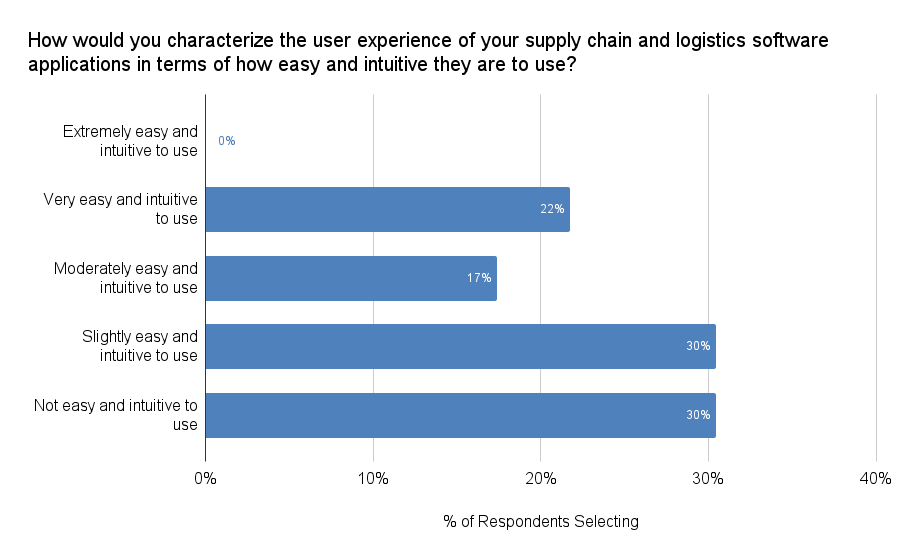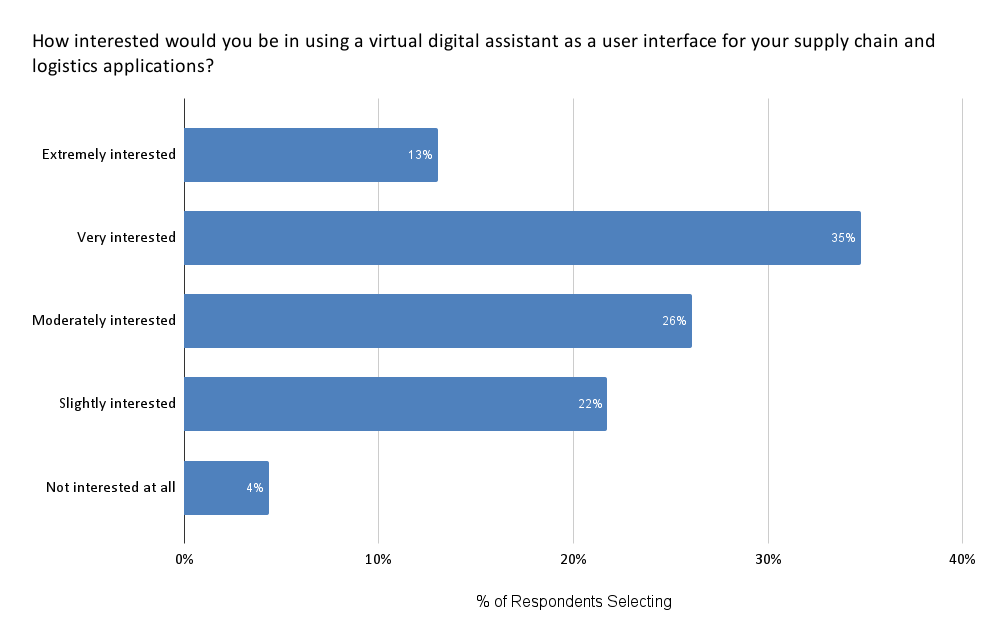Way back in 2013, in a post titled “Siri Comes to Enterprise Apps,” I wrote the following:
Instead of manually executing tasks with a mouse or touch screen, why not speak them? We already see this in the consumer realm with smartphones, and in the warehouse too with voice picking technologies. It’s only a question of time before speech recognition gets embedded into other enterprise and supply chain applications. A TMS user, for example, can say to the system, “Show me all uncovered loads,” or an inventory manager can ask, “Which stores have less than three days inventory of product X?” and up come the results on the screen.
Seven years later in a July 2020 post titled “Virtual Digital Assistants In Enterprise Software: The Journey To No Clicks,” I commented how “the migration from traditional user interfaces to chatbots and virtual digital assistants in the enterprise software space hasn’t been as fast as I had predicted [in 2013], but we keep moving forward, nonetheless.”
In June 2022 we conducted a survey with members of our Indago supply chain research community — who are all supply chain and logistics executives from manufacturing, retail, and distribution companies — where we asked them, “How would you characterize the user experience of your supply chain and logistics software applications?”
60% of our Indago member respondents characterized the user experience of their supply chain and logistics software applications as either “Slightly easy and intuitive to use” (30%) or “Not easy and intuitive to use” (30%). None of the respondents (0%) said their applications were “Extremely easy and intuitive to use.”

“Enterprise software user interfaces are just about the worst UI I’ve ever had to use,” said one supply chain executive. “The power behind them is truly amazing, but without extensive training and use, they’re all difficult to maneuver around and typically require a new dictionary of terms to use.”
We also asked our members, “How interested would you be in using a virtual digital assistant as a user interface for your supply chain and logistics applications?”
Almost half the respondents (48%) said that they would be “Very Interested” (35%) or “Extremely Interested” (13%) in using a virtual digital assistant as a user interface for their supply chain and logistics software applications. About a quarter of the respondents (26%) said that they would only be “Slightly Interested” (22%) or “Not Interested at All” (4%).

“I have been involved in TMS, WMS and ERP projects,” said one supply chain executive. “Virtual digital assistants would allow users to procure information quickly and allow for more analysis on the information and improve operations.”
Here are some other value-added comments submitted by the respondents:
“Having a virtual digital assistant as a supply chain software user interface is not my primary need. It would be better if the system provided the insights proactively without being asked. After that, the interaction with the virtual digital assistant would be interesting. I can picture a conversation leading to decisions and updated plans.”
“I think the best thing enterprise software vendors can do is continue to simplify their tools for users, or upgrade functionality with up-and-coming generations in mind. Tools need to be quick and easy to onboard, intuitive, non-repetitive, and to some degrees, fun to use; otherwise, it might result in users getting frustrated with the software or not using it. I think implementing virtual digital assistants would be a great way to interface with supply chain applications and I have already seen this type of solution implemented into Business Intelligence tools, which is huge for businesses. There are limitless [ways supply chain professionals can use this technology], and I would personally and professionally love to see virtual digital assistants implemented into SC technology.”
“We have [Amazon] Echo and Google hardware ‘assistants’ at home and they do not always work well. For business use, you’d want better precision. So, the technology does not seem to be ready yet.”
This survey, however, was conducted a few months before ChatGPT was introduced to the public in late November 2022. Since then, we have seen an acceleration of enterprise software vendors embedding virtual digital assistants (enabled by generative AI) into their applications. For example, at its Momentum conference in May 2024, Manhattan Associates announced “Manhattan Active® Maven, a specialized Generative Artificial Intelligence (GenAI) solution built for customer service, along with Manhattan Assist, which adds cutting-edge GenAI capabilities to all Manhattan Active solutions.” As described in the press release:
Natively built within Manhattan’s industry-leading omnichannel commerce solution, Manhattan Active Maven stands out as the first GenAI-powered customer service chatbot with native access to orders, payments, store locations, and product availability.
Manhattan has leveraged advancements in large language models (LLMs) to reimagine the chatbot experience for pre- and post-purchase experiences. Manhattan Active Maven crafts personalized responses that are dynamic and contextual, akin to those delivered by human agents.
Manhattan Assist [is] a GenAI-powered assistant that provides contextual responses to any questions regarding product functionality, API structures, and more. Manhattan Assist will also provide a natural language summary of how Manhattan Active applications are currently configured.
Another example is SAP, which at its SAP Sapphire conference in June 2024, announced that its generative AI copilot Joule, “which quickly sorts and contextualizes data from multiple systems to advance automation and improve decision-making, is expanding throughout the company’s solution portfolio.” Here are more details from the press release:
Joule launched in SAP SuccessFactors solutions last fall and is now embedded into SAP S/4HANA Cloud solutions and others including SAP Build and SAP Integration Suite. Further expansion by year-end will include SAP Ariba and SAP Analytics Cloud solutions. At Sapphire, SAP also announced plans to further broaden Joule’s scope by integrating it with Microsoft Copilot to surface even richer insights. This deep, bi-directional integration gives users a unified experience built right into the flow of work, enabling seamless access to information from interactions with business applications in SAP and Microsoft 365.
How can software vendors continue to improve the user experience of their applications? What do you see as the pros and cons of using virtual digital assistants as a way to interface with supply chain software applications? Post a comment and share your perspective on these questions.
I’ll end by repeating what I said in another post from 2013 titled, “Will Supply Chain Software Vendors Start Competing On Design?”:
Software vendors and customers need to think beyond features and functions. Of course, evaluating whether a software application meets your functional requirements remains critically important. But after that list has been checked off, you need to give equal time and consideration to evaluating the user experience. You also need to give power users, the people who have to work and deliver results with the application every day, a greater voice in the purchasing decision.










